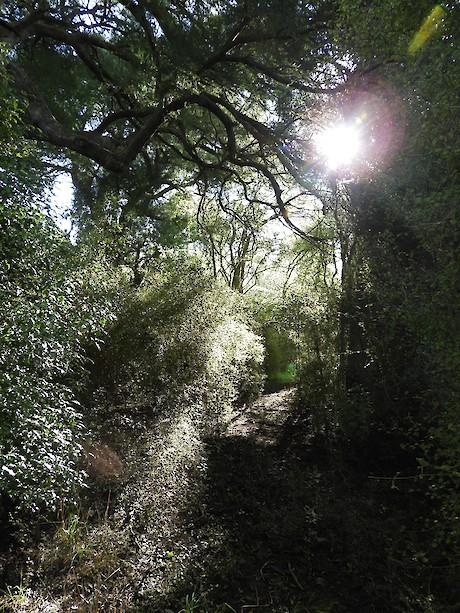Sherwood Forest – a Southland taonga for sale
 A walking track meanders through Sherwood Forest beneath ancient podocarps. Photo: Jesse BythellA one-of-a-kind property is currently for sale in Southland, just 25 minutes outside of Invercargill. The 29 ha property includes a 23 ha covenanted area of rare ancient floodplain forest, a house, pasture, a range of sheds and outbuildings, garage and stables. It is being sold by Ray White, you can see the full listing here:
A walking track meanders through Sherwood Forest beneath ancient podocarps. Photo: Jesse BythellA one-of-a-kind property is currently for sale in Southland, just 25 minutes outside of Invercargill. The 29 ha property includes a 23 ha covenanted area of rare ancient floodplain forest, a house, pasture, a range of sheds and outbuildings, garage and stables. It is being sold by Ray White, you can see the full listing here:
The covenant comprises a 23 ha covenanted block of riparian floodplain forest, shrubland and an oxbow lake located within the Southland Plains Ecological District (ED). An estimated 8% of indigenous forest remains in the Southland Plains ED, and an estimated 1% of riparian forest remains in the whole region.
Floodplain forests are dynamic and demanding places which support a range of at risk and threatened plants (12 in this covenant). The forest is ancient but historic disturbance (stock access, extreme weather events, hydrological changes) mean that the forest is in a recovery phase. Over 30 years of stock exclusion, predator and weed control and some supplementary planting around the edges are now paying off with healthy recruitment and recovery of the understorey.
There are three distinctive floodplain forest types in the covenant:
- Podocarp-hardwood forest
- This is the most common forest in the covenant and comprises an uneven canopy of mātai with occasional kahikatea and pōkākā.
- The understorey is made up of a range of broadleaf trees and shrubs including: Coprosma rotundifolia, C. propinqua, C. rubra, horopito, kōhūhū, kaikōmako, kāpuka, lowland ribbonwood, tōtara, kōwhai, putaputawētā, narrow-leaved māhoe, kōtukutuku, weeping, māpou and lancewood.
- Notable species include: Coprosma obconica and Melicytus flexuosus (Threatened – Nationally vulnerable), and Coprosma walli and C. pedicellata (At Risk – Declining).
- In canopy gaps grass may dominate and climbing vines are abundant, including pōhuehue, native jasmine, bush lawyer, climbing fuchsia, puawānanga and other clematis species.
- Riparian forest
- This forest type is confined to the edge of old meanders (sometimes referred to as levee forest) and it differs slightly from the podocarp-hardwood forest described above, with lowland ribbonwood and kōwhai more prominent and mātai less dominan
- Additional species include: Melicope simplex, Coprosma linariifolia, C. rigida and koromiko.
- Notable species include Hector’s tree daisy (Threatened – Nationally endangered), Coprosma virescens (At Risk – Declining) and fierce lancewood (At Risk – Naturally Uncommon).
- Kōwhai-Ribbonwood Forest
- Enclosed in the inner curve of the oxbow this forest is dominated by lowland ribbonwood and kōwhai and represents a fragment of terrace forest.
- Large Coprosma wallii and Melicytus flexuosus can be found here, and Coprosma pedicellata are abundant and this area is also the main habitat for Pittosporum obcordatum.
Threatened and At Risk vascular plant species at Sherwood Forest
Coprosma obconica Threatened – Nationally Vulnerable
Coprosma pedicellata At Risk - Declining
Coprosma virescens At Risk - Declining
Coprosma wallii At Risk - Declining
Korthalsella salicornioides Threatened – Nationally Critical
Melicytus flexuosusThreatened – Nationally Vulnerable
Neomyrtus pedunculata Threatened – Nationally Critical
Olearia hectorii Threatened –Nationally Endangered
Olearia lineata At Risk - Declining
Pittosporum obcordatum Threatened – Nationally Vulnerable
Pseudopanax ferox At Risk – Naturally Uncommon
Ranunculus kirkii At Risk – Naturally Uncommon
A species list can be found here.
For information about the property, contact:
Brendan Mason
021 399 402
[Enable JavaScript to view protected content]
Henry Mason
027 484 8750
[Enable JavaScript to view protected content]
For information about the ecological values, contact:
Jesse Bythell
QEII Rep for Southland
020 400 32109
[Enable JavaScript to view protected content]
Posted: 30/06/2022
